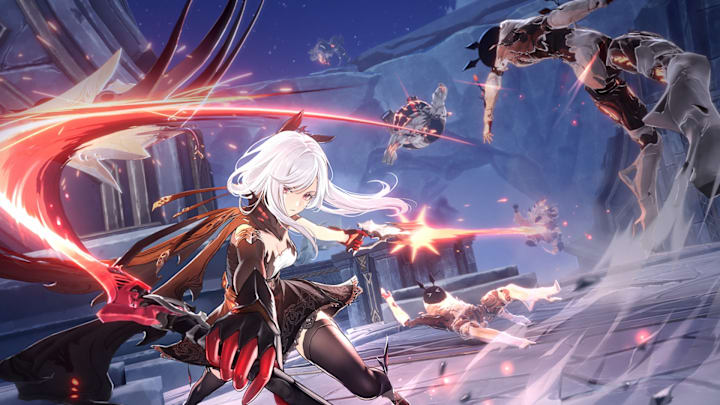Duet Night Abyss beta impressions: A few great ideas, shaky foundations
By Marco Wutz

Duet Night Abyss is one of the upcoming gacha games that aim to follow Genshin Impact’s path to worldwide fame and ever-flowing revenues. Its pitch? Genshin Impact marries Warframe.
Playing the ongoing second beta test of DNA, I see Warframe’s influence everywhere — from its combat system with its fluid switches between melee and ranged attacks to the way gear as well as characters can be modified.
Unlike famous examples like Genshin or Wuthering Waves, DNA doesn’t have you switch from character to character in combat. You only directly control one fighter from your roster, bringing up to two additional characters that can support you on the battlefield under AI control. It’s a bit like Arknights: Endfield in that regard, though Endfield retains the whole switching mechanic.
Characters have the usual array of basic attacks, skills, and ultimates you can level up with cooldown mechanics and a resource called Sanity ensuring that you can’t spam abilities.
Although every character may use all types of weapons in DNA, they all have specific masteries that commend them to at least one melee and one ranged weapon type. These include standard picks like swords, polearms, and pistols, but also some more exotic classes such as whipswords and grenade launchers.
Similar to Warframe, characters and weapons can be modified very freely with items you obtain from missions, allowing you to stack crucial stats on them — even at the cost of reducing some less important attributes.
Playing on PC, swapping weapons in combat couldn’t be easier: Your left mouse button lets you execute a melee attack, your right mouse button causes you to aim and shoot. This takes some time getting used to, granted, but works fine once you’ve memorized it. Combat generally feels fast and flashy, but is lacking some oomph — there is little weight behind attacks or shots. The different weapon categories contribute to playstyle variety, though the characters’ kits do much of the heavy lifting in this regard.
Where DNA falters is its movement system. For some reason, the developers seem to refuse including a sprinting feature, so getting anywhere on the map fast requires you to slide-jump, which is admittedly the only movement mechanic in the game that feels satisfying. Climbing feels awful most of the time, despite parkour being a pretty big aspect of the title — it’s miles behind Wuthering Waves in this area. Dodging in combat is so clunky that here, too, I’ve been relying on the slide-jump for my needs.
You can base your combat and equipment systems on Warframe as much as you want, if the movement – arguably Warframe’s crown jewel – doesn’t feel on point, any comparison will be negative by default.
Visually, the game is no step up from its peers at the moment, but this being a beta, it’s too early to tell how it’ll look after release. Some of the character designs look a bit basic, but that’s another area I don’t want to judge too harshly at this point. Overall, though, the presentation is robust with some great music tracks and solid voice acting.
DNA already shines when it comes to content variety. Aside from main and side missions – and I want to take a moment here to praise the main story and its themes, which’ve been intriguing and compelling so far – you have lots of speedrun and shooting challenges to tackle, can go out and catch Geniemon (which actually provide abilities in combat, so they become part of your character build), go fishing, play the roguelike game mode, and complete Commissions to farm level-up and crafting materials as well as equipment mods.
There is, of course, a daily energy mechanic: You need to pay Sanergy to claim rewards from Commissions, limiting your ability to grind and farm. Playing the story missions or side content doesn’t require Sanergy, though. While this is fairly standard in gacha games today, DNA isn’t currently storing any Sanergy overflow, meaning that some will be wasted if you don’t log in at least two times a day — not the end of the world, but not optimal for min-maxers.
Choices in a lot of gacha games feel like they have no consequences. DNA tackles this issue by recording all of your dialog selections and awarding you points in different categories based on your answers, such as Empathy, Chaos, or Wisdom. Some quests include Baldur’s Gate 3-style – and I’m citing BG3 intentionally here, because the entire mechanic is clearly inspired by it, UI and all – dice rolls, where these recorded values come into play. If you’ve chosen many Wisdom answers in the past, you get a higher bonus on your Wisdom dice roll, for example. It’s a neat addition to make dialog choices more important and even influences your relationships with the characters you pull, as they have different affinities and personality types as well.
Though an open-world style game at first glance, DNA really is an instance-based title with a world that’s a lot more chopped up into smaller areas. Sadly, the loading times are a bit long right now, even if you only load into a small house, which is frustrating.
If Pan Studio can fix the more fundamental issues of DNA – its movement system, chiefly – there is a good chance that it can establish itself on the competitive gacha game market.
The impressions described in this article are based on the PC build of the game.
More features on DBLTAP:
feed